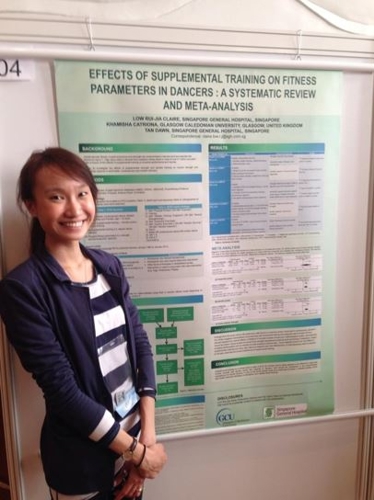5 Questions with Claire Low
Posted by: IADMS Student Committee

The Student Committee would like to introduce “5 Questions With…” a column designed to give students an opportunity to share something about themselves, their research, and their involvement with the International Association for Dance Medicine & Science (IADMS). Our first featured member is Claire Low, recipient of the Student Research Award in 2014 at the 24th Annual Meeting in Basel, Switzerland. She graduated from Glasgow Caledonian University and is currently a physiotherapist at Singapore General Hospital. Her areas of interest include dance injury, injury prevention, and Pilates for dancers.
How did you first get interested in dance science/medicine?
My love for dance started early; I was in baby ballet by the time I was 3 years old. Over the years of training, I realized that I was restricted and had difficulty executing a number movements such as turn out. My dream to continue classical ballet was dashed when an examiner told my dance teacher that I was not a suitable candidate during one of the vocational examinations. Heartbroken, I went to the local library to do research on why my body was "different." It was then I stumbled upon Karen Clippinger's book "Dance Anatomy & Physiology." I learned that my physical limitations were structural and not because I did not work hard enough. Where I trained, anatomy is usually not taught or explained during dance class. There also are not any screening protocols to assist teachers and students in assessing their functional capabilities before pursuing dance. It was then at 14 years old that I decided to pursue a career in physiotherapy, which would allow me to work with dancers to promote understanding about their own bodies and prevent dance injuries through education.
Are you currently participating in research? Can you give us your elevator pitch about your research area?
I am currently working on writing up a publication of my research "Effects of supplemental training on fitness parameters in dancers: A Critical Review and Meta-analysis," which was presented at the Annual Meeting. The review aims to update dancers and practitioners about what current studies recommend on the type and duration of supplemental exercise, versus normal dance training, in improving fitness parameters like muscle strength and endurance capacity in ballet, contemporary, and modern dancers.
What is the best thing about being a student member of IADMS?
Having access to the Journal of Dance Medicine & Science at a reduced rate! It helped me a lot with my dissertation, as most of the articles I used were published in JDMS and my university did not subscribe to it.
What has been your favorite IADMS experience?
Meeting the authors of my critical review in person at the Annual Meeting.
What would you say to a student thinking of joining IADMS?
Don't hesitate to join! Use the resources, especially JDMS, to broaden your knowledge. You also get to attend the Annual Meetings at discounted rates, which allows you meet other like-minded students as well as network with lecturers in the dance community.
If you’re interested in the Student Committee and it’s initiatives, contact us at student@iadms.org.
Special thanks to the “5 Questions With” sub-committee, Andrea Alvarez and Siobhan Mitchell.